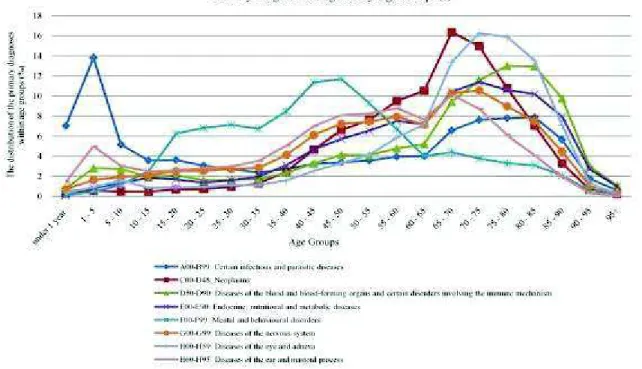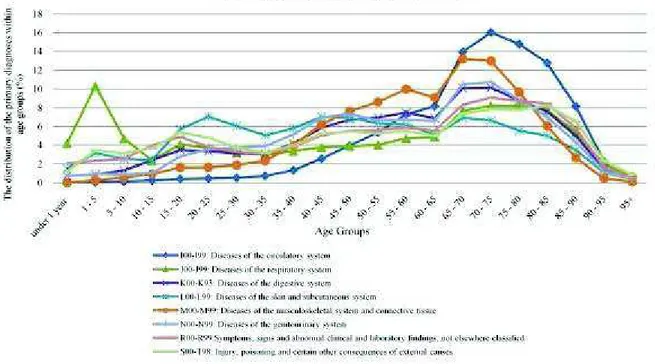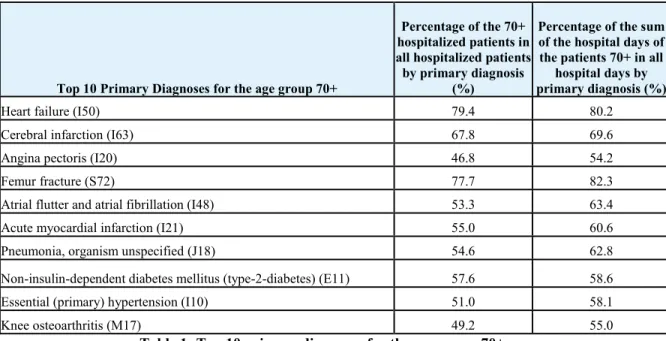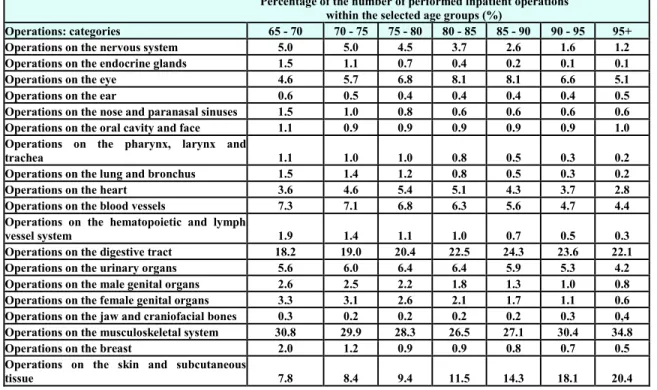221
THE ELDERLY PATIENTS IN THE GERMAN HOSPITAL SETTING: FACTS
AND FIGURES
Leuca Mirela
Faculty of Economics University of Oradea
Fastenmeier Heribert
Klinikum Ingolstadt GmbH
The demographic evolution and its consequences – population ageing - have been the topic of multiple research studies and analyses in many countries, industries or political regimes. Health care systems have been faced with questions regarding future financing, organization and resource allocation under the impact of the demographic evolution. This time is the hospital sector in focus. Analyzing the situation in German hospitals on the basis of recent, detailed statistical data and studies, this paper provides information, data and figures on elderly hospitalized patients with regard to costs, diagnoses and operations and presents briefly implications of the demographic evolution and of an ageing population for hospitals.
Keywords: hospitalized elderly patients, acute hospital care, demographic changes.
JEL Classification Code: I10 J10 M10
1.Introduction
The health care system of the European countries has been undergoing major changes related to the financing of the health care system, the allocation of resources, the spectrum, structure and organization of the health care service provision and also the access of the population to these services in the last decades. These health care reforms together with other factors of influence have had a great impact on the hospital sector in the European countries. Data provided by the World Health Organization Regional Office for Europe show that both the number of hospital and of hospital beds per 100,000 inhabitants decreased in the great majority of the member countries of the European Union in the last decades, but considerable differences between the member countries still persist. The average length of stay in acute care hospitals also diminished considerably, whereas the inpatient health expenditure per capita has been almost continuously rising, with small exceptions, in the member countries of the European Union.192 But the hospital sector in Europe is also facing a major challenge provided by the demographic evolution – the European hospitals will be caring for more and more elderly patients with special and often complex needs. In Germany, the patients aged 65 years and older discharged from German hospitals accounted in 2008 for about 42% of the cases registered in the hospital diagnosis statistics, whereas the patients aged at least 80 accounted for almost 14% of all primary diagnoses.193 The data referring to total health expenditure by age and disease groups in 2006 show that the average health expenditure per capita for the population aged at least 65 years and less than 85 is about 2.1 times higher (6090 €) and for the population aged 85 years and over about 5 times higher (14 370 €) than the average health expenditure per capita within all age
192 World Health Organization Regional Office for Europe,
European health for all database (HFA-DB), Copenhagen, Updated: January 2010, Online Version – selected parameters: Health Care Resources, Health Care Utilization and Expenditure.
193 Statistisches Bundesamt,
222
groups (2870 €).194 What for an impact will the demographic ageing process have on the health care system and on the hospital sector? The studies, data and publications available have been so far aiming at quantifying the impact of the demographic changes on the health expenditure, organizational structure and allocated resources and on the evolution of the medical specialties. This paper presents and analyzes some of the results of studies published on this topic and recent statistical data available with regard to the diseases and operations of the elderly hospitalized patients in Germany, trying to underline their characteristics and presents briefly implications of an ageing population for the German hospitals.
2. Characteristics of hospitalized elderly patients in Germany
There are many publications trying to estimate or predict the impact of the demographic evolution and of an ageing population on the health care expenditure, hospital cases, capacities and costs. There are more theses with regard to the evolution of morbidity at high ages, such as the compression of morbidity195 or the medicalization thesis196. The German hospital diagnosis statistics197 shows that the diseases of the circulatory system (about 2.7 million recorded primary diagnoses) accounted for the highest number of primary diagnoses of the hospitalized discharged patients in 2008 in Germany, followed by the neoplasms (about 1.9 million recorded primary diagnoses), by the diseases of the digestive system and of the category injury, poisoning and certain other consequences of external causes (each about 1.8 million recorded primary diagnoses), by the diseases of the musculoskeletal system and connective tissue (about 1.6 million recorded primary diagnoses), the top 6 diagnosis categories ending with the mental and behavioral disorders (about 1.1 million recorded primary diagnoses).
194 Statistisches Bundesamt,
Krankheitskosten nach Krankheitsklassen und Alter 2006 in EUR je Einwohner der jeweiligen Altersgruppe, Wiesbaden, 2008, online table document.
195 Fries, J.F.,
Compression of morbidity in the elderly, in: Vaccine, 2000, Nr. 18, pp. 1584 – 1589. 196 Verbrugge, L.M.,
Longer Life but Worsening Health? Trends in Health and Mortality of Middle-Aged and Older Persons, in: Milbank Memorial Fund Quarterly, 1984, Nr. 62, pp. 475-519.
197 Statistisches Bundesamt,
223
Figure 1: Primary Diagnosis Categories by Age Groups (I).
Source:authors’ own calculations based on available statistical data from Statistisches Bundesamt (2009a).198
The analysis of the diagnoses data for the patients aged 65 years and over shows that the top 5 diagnosis categories are identical with those of all discharged patients, followed by the but the diseases of the circulatory system on the 6th place. The diagnosis categories mental and behavioral disorders, certain infectious and parasitic diseases, diseases of the blood and blood-forming organs and certain disorders involving the immune mechanism, diseases of the skin and subcutaneous system and the diseases of the ear and mastoid process occupy the last 5 places in the top diagnosis categories for the group of patients aged 65 years and over. Figures 1 and 2 show that the highest frequencies of recorded primary diagnoses from the categories neoplasms, diseases of the musculoskeletal system and connective tissue and diseases of the ear and mastoid process are registered in the age group 65 – 70 years (patients aged at least 65 and less than 70 years).
224
Figure 2: Primary Diagnosis Categories by Age Groups (II).
Source:authors’ own calculations based on available statistical data from Statistisches Bundesamt (2009a).199
The highest frequencies of recorded primary diagnoses from the categories: diseases of the circulatory system, diseases of the genitourinary system, diseases of the digestive system, diseases of the nervous system, symptoms, signs and abnormal clinical and laboratory findings, not elsewhere classified, then endocrine, nutritional and metabolic diseases, and diseases of the eye and adnexa are registered in the age group 70 – 75 years (patients aged at least 65 and less than 70 years). The highest frequency for injury, poisoning and certain other consequences of external causes is to be found in the age group 80 – 85 years (patients aged at least 80 and less than 85 years). The percentage of the patients suffering from diseases of the circulatory system is in all 7 age subgroups 65+ (at least 65 years old) the highest among analyzed diagnosis categories, followed by the neoplasms in 3 age subgroups (65-70, 70-75, 75-80) and disease of the musculoskeletal system and connective tissue in 2 age subgroups (65-70, 70-75). For the last 4 age subgroups 65+ (80-85, 85-90, 90-95 and 95+) the next 2 highest percentages after the diseases of the circulatory system are registered by the categories injury, poisoning and certain other consequences of external causes and diseases of the digestive system. The data from table 1 shows that 6 of the 10 top primary diagnoses of the discharged patients aged 70 years and over in 2008 were diseases of the circulatory system.
199 Statistisches Bundesamt,
225
Top 10 Primary Diagnoses for the age group 70+
Percentage of the 70+ hospitalized patients in all hospitalized patients by primary diagnosis
(%)
Percentage of the sum of the hospital days of the patients 70+ in all
hospital days by primary diagnosis (%)
Heart failure (I50) 79.4 80.2
Cerebral infarction (I63) 67.8 69.6
Angina pectoris (I20) 46.8 54.2
Femur fracture (S72) 77.7 82.3
Atrial flutter and atrial fibrillation (I48) 53.3 63.4
Acute myocardial infarction (I21) 55.0 60.6
Pneumonia, organism unspecified (J18) 54.6 62.8
Non-insulin-dependent diabetes mellitus (type-2-diabetes) (E11) 57.6 58.6
Essential (primary) hypertension (I10) 51.0 58.1
Knee osteoarthritis (M17) 49.2 55.0
Table 1: Top 10 primary diagnoses for the age group 70+.
Source: authors’ own calculations based on statistical data from Statistisches Bundesamt (2009c).200
Table 2 indicates the gender differences with regard to the top 10 primary diagnoses (for example: angina pectoris, knee and hip osteoarthritis, arteriosclerosis, malignant neoplasms of bronchus and lung etc.) for the patients aged 70 and over discharged in 2008 from German hospitals. Analyzing the data with regard to surgical operations and procedures one can observe that the age group 65+ accounted for almost 42% of the inpatient surgical operations performed in German DRG-hospitals in 2008 (when not considering additional information on operations).201
Top 10 Primary Diagnoses: age group 70+, female Top 10 Primary Diagnosis: age group 70+, male
Heart Failure Heart Failure
Femur fracture Angina pectoris
Cerebral infarction Cerebral infarction
Essential (primary) hypertension Chronic ischemic heart disease Knee osteoarthritis Acute myocardial infarction Atrial flutter and atrial fibrillation Pneumonia, organism unspecified
Non-insulin-dependent Diabetes mellitus (type-2-diabetes) Other chronic obstructive pulmonary disease Acute myocardial infarction Malignant neoplasms of bronchus and lung
Angina pectoris Arteriosclerosis
Hip osteoarthritis Atrial flutter and atrial fibrillation
Table 2: Top 10 primary diagnoses for the age group 70+ by gender.
200 Statistisches Bundesamt,
Tiefgegliederte Diagnosedaten der Krankenhauspatientinnen und –patienten (Datensatzstruktur) 2008, Wiesbaden, 2009c, table: Geschlecht_Anzahl_08.
201 Statistisches Bundesamt,
226
Source: authors’ own calculations based on statistical data from Statistisches Bundesamt (2009c).202
Table 3 shows the percentage of the operation categories within all 7 subgroups 65+: the operations of the musculoskeletal system and of the digestive tract accounted for high percentages in all selected age groups (correlating with the information provided by the analysis of primary diagnoses by age groups) in the year 2008. Whereas the percentage of the operations on the nervous system, on the lung and bronchus, on the heart, on the blood vessels, on the male and female genital organs decreased in the higher age groups, the percentage of the operations on the skin and subcutaneous tissue and on the musculoskeletal system (partially) increased in the higher age groups.
Percentage of the number of performed inpatient operations within the selected age groups (%)
Operations: categories 65 - 70 70 - 75 75 - 80 80 - 85 85 - 90 90 - 95 95+ Operations on the nervous system 5.0 5.0 4.5 3.7 2.6 1.6 1.2 Operations on the endocrine glands 1.5 1.1 0.7 0.4 0.2 0.1 0.1 Operations on the eye 4.6 5.7 6.8 8.1 8.1 6.6 5.1 Operations on the ear 0.6 0.5 0.4 0.4 0.4 0.4 0.5 Operations on the nose and paranasal sinuses 1.5 1.0 0.8 0.6 0.6 0.6 0.6 Operations on the oral cavity and face 1.1 0.9 0.9 0.9 0.9 0.9 1.0 Operations on the pharynx, larynx and
trachea 1.1 1.0 1.0 0.8 0.5 0.3 0.2
Operations on the lung and bronchus 1.5 1.4 1.2 0.8 0.5 0.3 0.2 Operations on the heart 3.6 4.6 5.4 5.1 4.3 3.7 2.8 Operations on the blood vessels 7.3 7.1 6.8 6.3 5.6 4.7 4.4 Operations on the hematopoietic and lymph
vessel system 1.9 1.4 1.1 1.0 0.7 0.5 0.3
Operations on the digestive tract 18.2 19.0 20.4 22.5 24.3 23.6 22.1 Operations on the urinary organs 5.6 6.0 6.4 6.4 5.9 5.3 4.2 Operations on the male genital organs 2.6 2.5 2.2 1.8 1.3 1.0 0.8 Operations on the female genital organs 3.3 3.1 2.6 2.1 1.7 1.1 0.6 Operations on the jaw and craniofacial bones 0.3 0.2 0.2 0.2 0.2 0.3 0,4 Operations on the musculoskeletal system 30.8 29.9 28.3 26.5 27.1 30.4 34.8 Operations on the breast 2.0 1.2 0.9 0.9 0.8 0.7 0.5 Operations on the skin and subcutaneous
tissue 7.8 8.4 9.4 11.5 14.3 18.1 20.4
Table 3: Performed inpatient operations by age groups in 2008 in German DRG-hospitals. Source: authors’ own calculations based on statistical data from Statistisches Bundesamt (2009b).203
The data presented above shows that even at present the elderly patients register a high percentage in the number of inpatient hospital cases, of hospital days and absorb a high degree of the operation resources in German hospitals.
3. Implications of an ageing population for the German hospitals
The data presented above together with the values of the hospitalized patients per 1 000 inhabitants by age groups indicate that the number of inpatient hospital cases increases considerably at a high age.204 Under the premises of the representativeness of the statistical data
for the year 2008, one could expect a considerable increase of the age-related diagnoses as result
202 Statistisches Bundesamt,
Tiefgegliederte Diagnosedaten der Krankenhauspatientinnen und –patienten (Datensatzstruktur) 2008, Wiesbaden, 2009c, table: Geschlecht_Anzahl_08.
203 Statistisches Bundesamt,
Fallpauschalenbezogene Krankenhausstatistik (DRG-Statistik) - Operationen und Prozeduren der vollstationären Patientinnen und Patienten der Krankenhäuser – Ausführliche Darstellung - 2008, Wiesbaden, 2009, table 1.1.1.
204 Statistische Ämter des Bundes und der Länder,
227
of the demographic changes. Using the age and gender specific diagnoses probabilities of the years 2004/2005 and the results of population projections in order to quantify the impact of population ageing on the number of hospital cases and beds, one of the analyzed studies presented a projection scenario indicating an increase of about 12% in the hospitalized cases in 2030 compared to 2005; according to this projection scenario, high growth rates are expected in the age-related diagnoses categories, for e.g. diseases of the circulatory system (34.2%), neoplasms (20.9%), diseases of the digestive system (13.7%), injury and poisoning (10%), diseases of the musculoskeletal system and connective tissue (9.9%) and diseases of the respiratory system (11.5%). In the case of decreasing hospitalization rates (in accordance with the hypothesis of compression of morbidity205), the results of this projection scenario indicated an
increase of 5.3% in the hospitalized cases in 2030 compared to 2005. With regard to the percentages of the hospital inpatient cases by age groups, both scenarios showed similar results: the percentage of the age groups 60 - 80 and 80+ are predicted to increase from 35.5%, respectively 12.5% in 2005 to 39.5%/42.1%, respectively 20.2%/20.4% in 2030.206 On the basis of the analyzed data, one can say that the implications of an ageing population for the German hospitals will be multiple and complex, ranging from changes in the diagnosis spectrum, allocated resources (number of beds, operation resources and capacities, qualifications of the hospital personnel, care effort etc.) to changes in the hospital organizational structure and processes (for e.g. case management, coordination activities and discharge management). The characteristics and often complex needs of the elderly patients require more than ever the implementation of multi- and interdisciplinary care concepts in hospitals. Due to the expected increase of the percentage and number of the patients aged 70/80 and over, German hospitals should consider the necessity of ensuring geriatric medicine knowledge in the hospital setting.
4.Conclusions
Many data illustrate implications of the demographic evolution for European health care systems. The hospital sector, as integrative part of each heath care system, will be also facing challenges and changes. The precise analysis of the patient hospital structure and their characteristics can provide hospitals with important information and enable them to react in time by adopting necessary structural and organizational measures in order to be well prepared for the multiple facets of the demographic evolution.
Bibliography:
1. Fries, J.F. (2000): Compression of morbidity in the elderly, in: Vaccine, Nr. 18, pp. 1584 – 1589.
2. Statistische Ämter des Bundes und der Länder (2008): Demographischer Wandel in Deutschland, Heft 2 – Auswirkungen auf Krankenhausbehandlungen und Pflegebedürftige im Bund und in den Ländern, Wiesbaden.
3. Statistisches Bundesamt (2008): Krankheitskosten - Kosten nach Krankheitsklassen und Geschlecht in EUR je Einwohner, Wiesbaden, online table document, URL:
http://www.destatis.de/jetspeed/
portal/cms/Sites/destatis/Internet/DE/Content/Statistiken/Gesundheit/Krankheitskosten/Tabellen/ Content75/KrankheitsklassenGeschlecht,templateId=renderPrint.psml (last access: 24.04.2010).
4. Statistisches Bundesamt (2009a): Diagnosedaten der Krankenhauspatientinnen und - patienten (einschl. Sterbe- und Stundenfälle), Fachserie 12 Reihe 6.2.1 – 2008, Wiesbaden, publishing date: 15.12.2009.
205 Fries, J.F.,
Compression of morbidity in the elderly, in: Vaccine, 2000, Nr. 18, pp. 1584 – 1589. 206 Statistische Ämter des Bundes und der Länder,
228
5. Statistisches Bundesamt (2009b): Fallpauschalenbezogene Krankenhausstatistik (DRG-Statistik) - Operationen und Prozeduren der vollstationären Patientinnen und Patienten der Krankenhäuser – Ausführliche Darstellung - 2008, Wiesbaden, publishing date: 20.11.2009.
6. Statistisches Bundesamt (2009c): Tiefgegliederte Diagnosedaten der Krankenhauspatientinnen und –patienten (Datensatzstruktur) 2008, Wiesbaden, publishing date: 23.12.2009.
7. Verbrugge, L.M. (1984): Longer Life but Worsening Health? Trends in Health and Mortality of Middle-Aged and Older Persons, in: Milbank Memorial Fund Quarterly, Nr. 62, pp. 475-519.
8. World Health Organization Regional Office for Europe (2010): European health for all database (HFA-DB), Copenhagen, Updated: January 2010, Online Version – selected parameters: health care resources, health care utilization and expenditure, URL:



